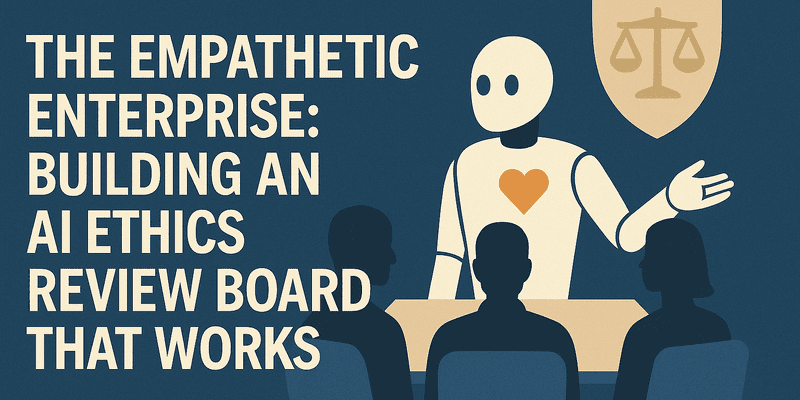The Empathetic Enterprise: Building an AI Ethics Review Board That Works

Tim King offers insight on building an AI ethics review board for the empathetic enterprise, part of Solutions Review’s coverage on the human impact of AI.
As artificial intelligence moves from experimental tools to enterprise-wide infrastructure, the stakes of every algorithmic decision grow exponentially. No longer confined to backend systems or data analytics, AI now shapes who gets hired, what price a customer sees, how performance is evaluated, and even what medical or financial opportunities are offered. These aren’t just technical outputs—they’re moral choices carried out at machine scale. And with that scale comes risk: bias, exclusion, overreach, opacity, and unanticipated harm. That’s why organizations serious about responsible innovation must move beyond vague ethical intentions and implement formal structures of accountability.
Enter the AI Ethics Review Board (AIERB)—the empathetic enterprise’s internal compass for ensuring AI aligns not just with business goals, but with human values. It’s not a bureaucratic hurdle. It’s a safeguard for dignity, fairness, and trust in a time when automated decisions can feel impersonal and impenetrable. For companies building an Empathetic AI Framework, the AIERB is where empathy becomes operationalized—where diverse voices review potential impacts, where human consequences are surfaced before systems go live, and where real authority exists to say, “Not yet,” or even “Not at all.” In this era of accelerated transformation, having a thoughtful, empowered, and interdisciplinary ethics board isn’t just best practice—it’s a moral and strategic necessity. Because as AI gets smarter, enterprises must get more human. And that starts with building a board that keeps people at the center of every decision machine.
Why Empathy Demands Ethics
At the heart of every responsible AI strategy lies a moral imperative: to ensure that technological advancement does not come at the cost of human dignity. This is where empathy and ethics converge. Empathy is the ability to understand and value human experience, while ethics is the discipline that translates those values into action.
When artificial intelligence begins to influence hiring, healthcare, policing, compensation, or opportunity, it no longer lives in the abstract—it shapes lives. And when AI makes decisions that impact people, organizations must make decisions about AI with care. This is not just about compliance with regulations; it’s about cultivating trust, preserving agency, and preventing harm. An AI Ethics Review Board (AIERB) serves as the operational embodiment of that empathy, ensuring that ethical questions are not deferred, ignored, or outsourced—but addressed openly, collaboratively, and with accountability.
In an empathetic enterprise, ethics is not a brake on innovation; it is the steering wheel. It helps organizations not only avoid harm, but design for fairness, transparency, and long-term legitimacy.
AI Ethics Review Board Example
The Role of an AI Ethics Review Board
An AI Ethics Review Board (AIERB) is more than a symbolic gesture—it is a structured, decision-capable body that exists to embed ethical reasoning into the core of how an organization develops, purchases, deploys, and monitors artificial intelligence.
As AI technologies touch increasingly sensitive domains, from employee surveillance to algorithmic hiring to customer profiling, the risks of unintended harm grow exponentially. The role of the AIERB is to identify those risks before they become outcomes. It acts as an internal conscience, asking the hard questions about fairness, transparency, consent, and power imbalance.
At a procedural level, the board is responsible for reviewing high-impact AI systems prior to deployment, ensuring those systems undergo rigorous impact assessments, fairness testing, and documentation of purpose and scope. It has the authority to approve, delay, or reject use cases based on ethical criteria. It may also be tasked with reviewing third-party vendor systems for alignment with the organization’s standards.
Importantly, the AIERB is not a one-time reviewer but a persistent governance mechanism. It monitors post-deployment outcomes, investigates complaints or red flags, and can recommend system changes or suspensions. In mature programs, the board reports regularly to senior leadership or even the board of directors, elevating AI ethics to the same level as financial risk or brand integrity.
Key Design Principles for an Empathetic AI Ethics Review Board
Designing an effective AI Ethics Review Board (AIERB) requires more than selecting a few senior leaders and assigning them oversight. It demands intentional architecture that reflects the interdisciplinary, high-stakes nature of ethical AI governance—especially within an empathetic enterprise.
First and foremost, the board must be cross-functional. AI ethics is not purely technical, legal, or philosophical; it is all of these and more. Board members should represent diverse perspectives from data science, legal, compliance, human resources, DEI, product, and front-line employee roles. Including rotating seats or external advisors can bring needed independence and critical distance. Second, the board must operate on a risk-based review trigger model.
Not every AI system merits full review, but any system affecting human livelihoods, legal rights, or access to opportunity should undergo mandatory ethical assessment. Clear criteria—based on impact, sensitivity, and reversibility—help prevent review bottlenecks while prioritizing human consequence.
Third, the board must have structured workflows and documentation protocols. Submitting teams should provide a standardized packet including an AI Impact Review, fairness and bias testing results, a Deployment Ethics File (DEF), and a plain-language purpose statement.
These inputs should be evaluated using a consistent framework that weighs risk, benefit, alternatives, and mitigation plans. Fourth, red flag and escalation pathways must be clearly defined. The board needs real authority—not just the power to advise, but the power to pause or halt deployments when ethical concerns are unresolved. Fifth, the board must have post-deployment oversight responsibilities. Ethical risk doesn’t end at go-live. The board should receive regular reports on model performance, incident trends, and system modifications that could trigger re-review. And sixth, the board must make space for stakeholder and employee voice.
Empathy means listening to those affected by AI—not just those who build it. This could include anonymous feedback portals, designated employee seats, or user research summaries as required review materials. These principles ensure the board is not just procedural, but protective—and that it reflects the lived experience of those who stand to benefit or be burdened by AI decisions.
Embedding Empathy into AIERB Governance
Embedding empathy into the governance of artificial intelligence means intentionally designing systems of oversight that prioritize human experience over mere efficiency. For an AI Ethics Review Board (AIERB), this means shifting the focus from compliance to compassion, from minimum viable risk to maximum responsible care.
It begins with the mindset that every AI system impacts real people—and that those impacts must be understood, anticipated, and mitigated with empathy as a guiding principle. In practice, this means the board doesn’t simply ask “Does this system comply with our standards?” but also, “How will this system feel to the person it affects?”
Empathy-driven governance incorporates scenario modeling that surfaces not just intended use cases, but worst-case human consequences. It demands that board members challenge design assumptions by stepping into the shoes of those being scored, monitored, assessed, or filtered by algorithms.
Embedding empathy also requires reviewing AI systems in context—not just as abstract technologies, but as tools embedded in complex social systems. A system that appears fair in testing may reinforce workplace hierarchies or cultural biases once deployed. An empathetic board probes these dynamics. It questions the power imbalances between who builds the system and who is subject to it. It considers the psychological toll of surveillance, the dignity of manual review, and the downstream ripple effects of automated decision-making.
Empathy is also embedded structurally through stakeholder representation. Giving impacted employees or users a voice in review decisions—whether through participation, anonymized testimony, or survey data—ensures governance is grounded in lived experience. And empathy means requiring explainability not as a technical feature, but as a moral obligation: if a system affects someone’s livelihood, they have a right to understand how.
Ultimately, embedding empathy into AIERB governance transforms the board from a gatekeeper of compliance into a guardian of trust. It ensures AI does not just function—but respects, protects, and dignifies the people it touches.
Measuring Ethical Oversight Effectiveness
To ensure that an AI Ethics Review Board (AIERB) is more than symbolic—more than a well-meaning committee with no teeth—organizations must define and track specific metrics that evaluate how well ethical oversight is functioning. In the context of an empathetic enterprise, measurement is not about vanity; it’s about verifying that structures designed to protect human dignity are actually doing so.
One of the most telling metrics is the percentage of AI systems reviewed by the board before deployment. This figure reflects whether ethical governance is being consistently applied or bypassed under pressure to ship fast or avoid scrutiny. A high review rate—especially for systems with high impact or sensitivity—demonstrates that ethical review is embedded in operational processes. A low rate suggests a breakdown in enforcement or culture.
Complementing this is the percentage of AI systems with completed Deployment Ethics Files (DEFs) and AI Impact Reviews. These documents capture the intent, assumptions, risks, mitigation strategies, and fairness testing related to each system. When completed thoroughly and reviewed systematically, they provide an auditable record of ethical due diligence and preemptive accountability. In sensitive domains, organizations should also track the percentage of AI deployments escalated to senior leadership or board-level oversight, as this reflects whether high-risk systems are being evaluated at the appropriate level of organizational responsibility.
Other meaningful indicators include the number of red flag incidents reported, the average time-to-resolution for ethics-related issues, and the percentage of appeals or complaints that result in system changes (e.g., model retraining, increased human oversight, or decommissioning). These metrics show not only how responsive the organization is to ethical concerns, but whether governance mechanisms have real corrective power.
Additionally, the frequency of AIERB meetings, average attendance rates, and percent of retrained or materially altered systems that are re-reviewed help gauge whether governance is being maintained over time or allowed to lapse post-launch.
Together, these metrics allow leadership to identify blind spots, measure cultural compliance, and reinforce ethical rigor. They send a clear message that the AIERB is not a rubber stamp—it is a critical institution that ensures AI systems do not drift silently from helpful to harmful. By measuring ethical oversight, the enterprise affirms that trust and accountability are not abstract values, but operational priorities.
A Governance Framework Built for the Future
In a world where artificial intelligence is evolving faster than regulation and impacting lives faster than most organizations can track, the need for forward-looking ethical governance has never been greater. The AI Ethics Review Board (AIERB), when structured thoughtfully and operated with empathy, becomes more than a safeguard—it becomes a strategic advantage. It ensures that innovation is not pursued blindly, but with moral clarity and human respect.
As enterprises scale their use of AI across hiring, productivity, personalization, risk modeling, and more, the potential for both benefit and harm grows. The future will not be kind to companies that ignore this duality. Trust, reputation, employee loyalty, and regulatory readiness will increasingly hinge on the visibility and credibility of AI governance practices.
A governance framework built for the future must be flexible enough to evolve with the pace of technology, yet principled enough to remain anchored in enduring human values. It must integrate empathy not as an afterthought, but as a design input—baked into review checklists, stakeholder interviews, system documentation, and final approvals.
It must accommodate cross-border deployments, third-party tools, and foundation models whose internal logic may be opaque even to their creators. And most of all, it must be people-centered. AI systems are not just code—they are policies in action. They affect real people, in real ways, every day.
The empathetic enterprise recognizes that ethics is not a limitation—it is a form of leadership. By building and empowering an AIERB, organizations declare that their AI systems will not only be effective, but just. Not only powerful, but accountable. Not only innovative, but inclusive. Such a framework builds more than compliant systems—it builds resilient, future-ready organizations that earn trust and deserve it.
Note: These insights were informed through web research and generative AI tools. Solutions Review editors use a multi-prompt approach and model overlay to optimize content for relevance and utility.



